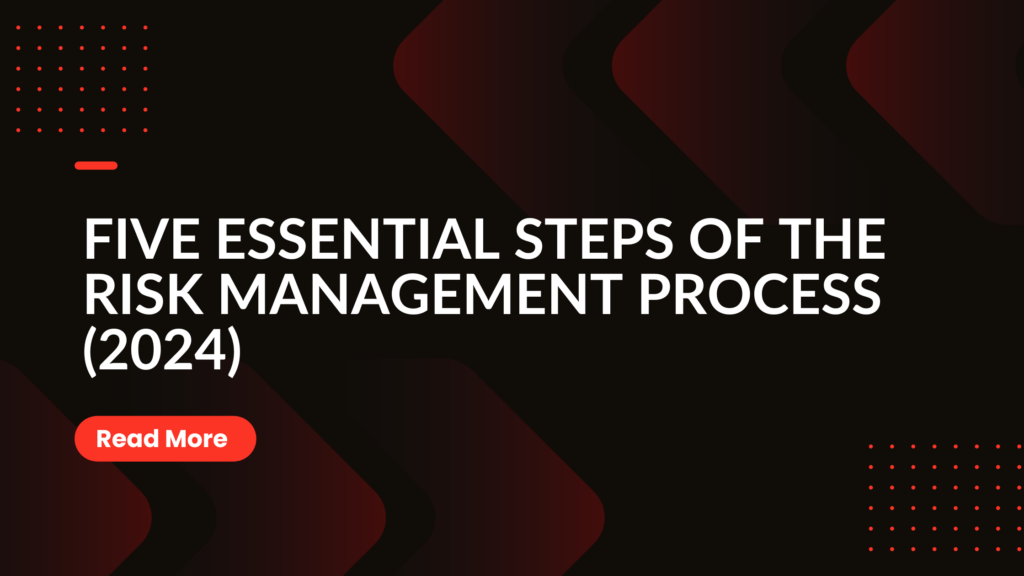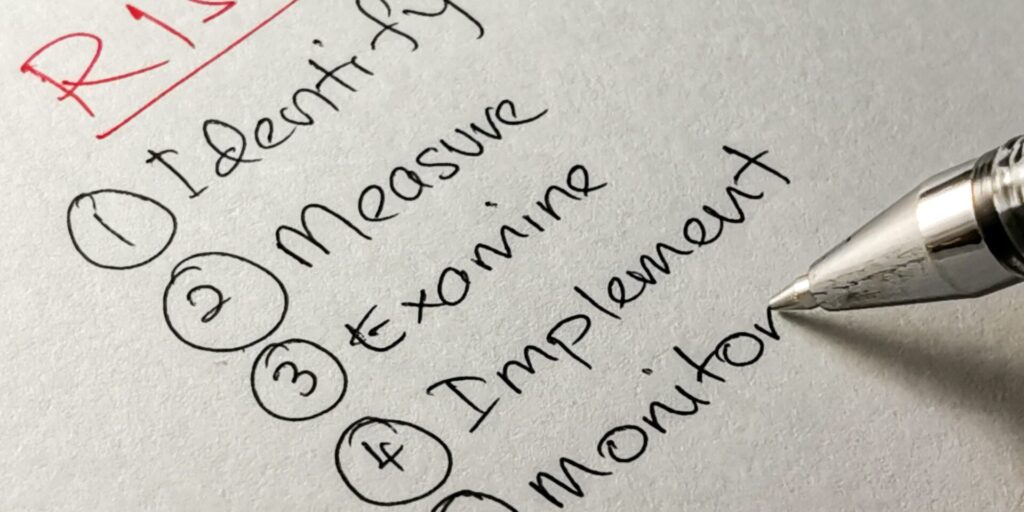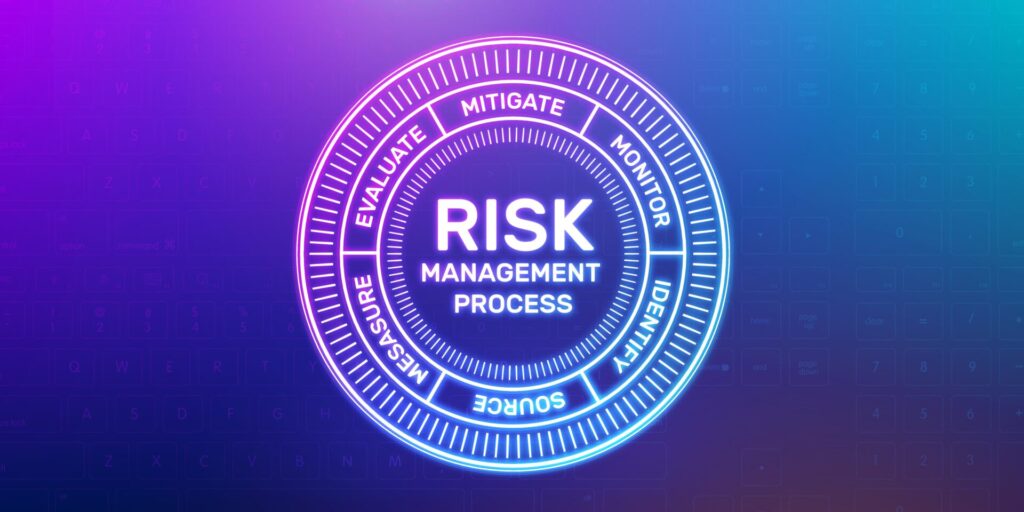Five Essential Steps of the Risk Management Process (2024)

The risk management process is pivotal for businesses across all industries, aiming to minimize risks while maximizing opportunities. Understanding and implementing each step of this process is crucial for maintaining organizational resilience and achieving long-term success. This guide will delve into the five essential steps of the risk management process, providing expert insights and practical strategies to manage risks effectively.
Table of Contents
Introduction
Risk management is an essential discipline that helps organizations identify, assess, and control threats to their capital and earnings. These threats, or risks, could stem from a wide variety of sources including financial uncertainties, strategic management errors, legal liabilities, accidents, and natural disasters. A robust risk management process is vital for the stability and prosperity of any business as it prepares them to effectively handle potential risks. By adopting a structured approach to managing uncertainties, organizations can ensure continuity, enhance operational effectiveness, and ultimately boost their overall profitability.
You can also read- Top 10 Best Phishing Tools for Advanced Protection (2024)
What is the Risk Management Process?
The risk management process is a systematic approach to identifying, evaluating, and responding to potential risks that could negatively impact an organization. It involves assessing the likelihood and consequences of such risks, prioritizing them, and implementing strategies to mitigate or transfer the identified risks, ensuring continuous monitoring and adaptation as conditions change.
Five Steps of a Risk Management Process
The five steps of the risk management process are given below.

Step 1 – Identify Risk
The first step in the risk management process is identifying potential risks that could negatively affect an organization. Risks can be broadly categorized into several types:
- Strategic Risks: These include changes in market conditions, competitive pressures, or strategic decisions that do not perform as expected.
- Operational Risks: These are risks associated with the operational aspects of an organization, including system failures, employee errors, or disruptions in supply chains.
- Financial Risks: These involve financial losses due to market fluctuations, credit issues, or inadequate financial planning and management.
- Compliance Risks: These arise from potential violations of laws, regulations, or prescribed practices.
- Environmental Risks: These include natural disasters or conditions that could impact the organization’s operations.
- Reputational Risks: These are risks that could harm an organization’s reputation or standing, possibly leading to a loss of business or increased costs.
Tools for Risk Identification
To effectively identify risks, organizations can utilize a variety of tools and techniques:
- Brainstorming Sessions: Engaging teams across the organization to collectively think about potential risks.
- Checklists: Using standardized checklists based on historical company data or industry-specific risks.
- Interviews and Surveys: Gathering insights from employees, customers, and experts about perceived risks.
- SWOT Analysis: Assessing strengths, weaknesses, opportunities, and threats to identify strategic and operational risks.
- Risk Workshops: Conducting dedicated workshops or seminars to systematically explore potential risk scenarios.
- Root Cause Analysis: Investigating past events to identify underlying risks and vulnerabilities.
- PEST Analysis: Reviewing political, economic, social, and technological factors that could impact the organization.
Step 2 – Assess Risk
Once risks are identified, the next step is to assess their potential impact and likelihood. Risk assessment can be conducted through two primary methods: qualitative and quantitative.
- Qualitative Assessment: This method involves evaluating risks based on subjective criteria, such as the severity of impact and the likelihood of occurrence. It often uses descriptors like “high,” “medium,” or “low” to rate risks. This approach is particularly useful when statistical data is scarce but expert opinions and historical data are available.
- Quantitative Assessment: In contrast, quantitative risk assessment uses numerical values and statistical models to measure risk. This might involve calculating potential financial losses or using probability distributions to understand the likelihood of a risk’s occurrence and its potential impact. Quantitative assessment provides a more precise, data-driven analysis of risks.
Risk Probability and Impact
- Probability of Occurrence: Each risk is analyzed to determine how likely it is to occur. This could be expressed as a percentage, a frequency over time, or a rating on a scale from “very unlikely” to “almost certain.”
- Impact Assessment: This involves determining the potential consequences of each risk if it were to materialize. The impact can be assessed in terms of financial loss, damage to reputation, safety implications, or operational disruption.
To effectively analyze and prioritize risks, organizations often employ tools like:
- Risk Matrices: A risk matrix helps visualize and prioritize risks by plotting them according to their probability and impact. This tool is invaluable in highlighting which risks need immediate attention and which may be less urgent.
- Risk Registers: A risk register is a comprehensive document that lists all identified risks along with their assessment and proposed management strategies. It serves as a tracking tool throughout the risk management process.
- Scenario Analysis: This involves developing different scenarios to understand the potential outcomes of risky events. It helps in examining the effectiveness of proposed risk response strategies under various conditions.
Step 3 – Prioritize Risks
After assessing each risk for its likelihood and impact, the next critical step is to prioritize them. This is where the risk matrix becomes a vital tool. A risk matrix helps in visualizing and ranking risks based on their severity and probability. It typically divides risks into categories such as low, moderate, high, and critical. Each risk is plotted on a two-dimensional grid: one axis represents the likelihood of the risk occurring, and the other represents the potential impact on the organization.
- Low Priority: Risks that appear in the lower left quadrant (low likelihood and low impact).
- Moderate Priority: Risks in the middle of the matrix, requiring regular reviews to monitor any changes in likelihood or impact.
- High Priority: Risks that are likely to occur and have significant consequences, necessitating immediate attention.
- Critical Priority: Risks in the upper right quadrant, which are both highly likely to occur and have severe impacts, demand urgent action plans.
Criteria for Prioritization
The prioritization of risks involves more than just assessing their position on a risk matrix. It also considers the organization’s overall risk appetite, strategic goals, and available resources. Here are some criteria commonly used to prioritize risks:
- Strategic Alignment: How significantly does the risk affect the organization’s strategic objectives? Risks that threaten key goals or long-term plans are often given higher priority.
- Resource Availability: What resources are available to address the risk? Risks that can be mitigated with available resources may be prioritized differently compared to those requiring substantial new investments.
- Regulatory and Compliance Requirements: Are there legal or regulatory consequences associated with the risk? Compliance-related risks often receive higher priority due to the legal implications of non-compliance.
- Impact on Stakeholders: How does the risk affect different stakeholders, including customers, employees, and partners? Risks with a broader or more severe impact on stakeholders are typically prioritized higher.
Step 4 – Implement Risk Responses
Once risks are prioritized, organizations must implement appropriate response strategies to manage these risks effectively. The chosen strategy will largely depend on the nature of the risk and the organization’s risk tolerance. Here are the key strategies typically used in risk management process:
- Avoidance: This involves altering plans or processes to completely avoid the risk. For instance, an organization may decide not to enter a high-risk market or not to use a particular technology known for its vulnerabilities.
- Reduction: This strategy aims to reduce the likelihood of the risk occurring or its potential impact. It might involve introducing safety measures, enhancing security protocols, or providing additional training to staff.
- Transfer: Risk transfer involves shifting the risk to a third party, such as purchasing insurance or outsourcing certain operations to vendors who can better manage the associated risks.
- Acceptance: Some risks may be accepted, particularly if they are low in priority or if the cost of mitigation exceeds the potential loss. This decision usually comes with a plan for managing the risk’s impact if it materializes.
Risk Transfer Techniques
Specific techniques can be employed to transfer risk effectively:
- Insurance: Purchasing insurance coverage is a common method to transfer financial risks related to theft, damage, liability, and other unforeseen events.
- Contracts: Using contracts to transfer risks to other parties, such as suppliers or partners, by including terms and conditions that specify who bears the responsibility for managing certain risks.
- Hedging: In financial operations, hedging involves taking an offsetting position in a related asset to manage the risk of adverse price movements.
Step 5 – Monitor and Review
Monitoring is a continuous and dynamic process that plays a crucial role in the risk management lifecycle. It involves tracking the status of identified risks and the effectiveness of the measures put in place to mitigate them. Regular monitoring ensures that any changes in the environment or internal operations that may affect the risk levels are detected and addressed promptly. Effective monitoring can include:
- Automated Risk Tracking Tools: Implementing software solutions that provide real-time data on risk indicators and trends.
- Regular Audits and Assessments: Conducting scheduled audits to ensure compliance and effectiveness of risk management strategies.
- Performance Reviews: Evaluate the outcomes of risk response strategies to determine if they are working as intended or need adjustments.
- Stakeholder Feedback: Gathering insights from employees, customers, and vendors to get a comprehensive view of risk management performance and perception.
Review and Reassessment Methods
Risk review and reassessment are critical to adapting the risk management process to new threats and opportunities. This step involves revisiting the risk management plan at regular intervals or after significant events to make necessary updates. Key activities include:
- Periodic Risk Reassessments: Regularly scheduled reviews to update risk priorities as business objectives or external conditions change.
- Event-driven reassessments: Triggered by specific incidents or changes in the business environment, such as new regulatory requirements, technological advancements, or significant operational changes.
- Lessons Learned: Analyzing risk events after they occur to derive lessons that can improve future risk handling. This often involves identifying any shortcomings in the current risk management approach and making adjustments.
How do you develop a risk management plan?
A comprehensive risk management plan is crucial for guiding an organization through the steps of identifying, assessing, responding to, and monitoring risks. Key components of a successful plan include:
- Risk Identification Summary: Document all potential risks identified through various assessment tools.
- Risk Assessment Results: Detailing the findings from qualitative and quantitative risk assessments, including probability and impact.
- Risk Prioritization: Listing risks in order of priority based on their impact on organizational objectives and risk appetite.
- Risk Response Strategies: Outlining specific strategies for avoiding, reducing, transferring, or accepting risks.
- Roles and Responsibilities: Clearly define who is responsible for each aspect of risk management, from initial assessment to implementation and monitoring.
- Monitoring and Review Procedures: Establishing protocols for ongoing risk evaluation and the criteria for triggering reassessments.
- Budget and Resources: Allocating resources necessary for implementing risk mitigation strategies, including time, personnel, and finances.
- Communication Plan: Ensuring all stakeholders are informed about the risk management process and any updates.
Challenges in the Risk Management Process

Despite best efforts, organizations can face several challenges in risk management, including:
- Underestimating Risks: Failing to recognize or adequately prepare for risks that might seem unlikely but could have severe consequences.
- Resource Constraints: Lack of sufficient resources to effectively implement risk management strategies.
- Resistance to Change: Organizational inertia or resistance from employees who are accustomed to existing processes and skeptical of new practices.
- Information Silos: Critical risk information confined within certain departments or levels, preventing a cohesive risk response.
Benefits of Effective Risk Management Process
There are multiple benefits of the risk management process. A few of the risk management processes are given below.
Enhanced Decision Making
By understanding and controlling risks, decision-makers can make more informed, confident choices that align with the organization’s risk appetite and strategic goals. This leads to better outcomes and avoids costly mistakes caused by overlooked or misjudged risks.
Improved Financial Performance
Effective risk management not only helps in avoiding losses but also optimizes the use of resources and enhances operational efficiency, thereby improving the overall financial health of the organization. This can lead to increased profitability and shareholder value, as well as greater stability in financial planning and performance.
Conclusion
An effective risk management process is essential for any organization aiming to navigate the complexities of today’s business environment. By systematically identifying, assessing, prioritizing, implementing, monitoring, and reviewing risks, organizations can protect themselves against potential threats while capitalizing on opportunities. Integrating the risk management process with daily operations and strategic planning enhances decision-making, improves financial performance, and builds a resilient organizational culture.
You can also read – 15 Best ZeroFox Competitors and Alternatives
FAQs of the Risk Management Process
What is the most important step in the risk management process?
While all steps of the risk management process are important, risk assessment is critical as it determines the severity and likelihood of risks, shaping how they are managed.
How often should the risk management plan be reviewed?
The risk management plan should be reviewed at least annually, or more frequently if there are significant changes in the business environment, operational processes, or following a major risk event.
Can risk management help in gaining a competitive advantage?
Yes, effective risk management can provide a competitive advantage by enabling better decision-making, reducing losses, and fostering a proactive approach to potential challenges.